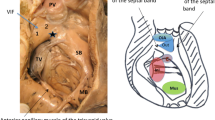Abstract
Left ventricular noncompaction (LVNC) is a form of cardiomyopathy resulting from a disorder of endomyocardial morphogenesis. It has been associated with significant morbidity and mortality. The aim of this study was to characterize associated cardiac findings in children with LVNC and to identify risk factors associated with increased mortality. From our echocardiography database, we identified 46 patients diagnosed with LVNC between December 1999 and February 2005. The mean age at presentation was 3.6 ± 5.6 years, and the mean duration of follow-up was 1.9 ± 2.1 years. Left ventricular ejection fraction was decreased in 24 patients (52%; mean 39.5% ± 13.1%). Thirty-six patients (78%) had associated cardiac lesions, including atrial septal defect (n = 16 [35%]), ventricular septal defect (n = 17 [37%]), patent ductus arteriosus (n = 14 [30%]), and Ebstein’s anomaly (n = 5 [11%]). Electrocardiogram abnormalities were found in 80% of patients; most commonly they included left (n = 15 [43%]) and right ventricular hypertrophy (n = 19 [54%]). Documented arrhythmias included ectopic atrial rhythm (n = 2), junctional rhythm (n = 2), supraventricular tachycardia (n = 2), and ventricular tachycardia (n = 1). Overall mortality was 20%, and there was no association with ejection fraction, morphologic defect, or arrhythmia. Mean age at diagnosis in survivors (4.5 ± 6.1 years) was higher than nonsurvivors (0.4 ± 0.7 years) (p < 0.0001). LVNC is a rarely isolated form of cardiomyopathy, and it is associated with significant additional cardiac abnormalities. Although it does not have an invariably fatal course, early presentation in infancy does carry an increased risk of mortality.


Similar content being viewed by others
References
Celiker A, Ozkutlu S, Dilber E et al (2005) Rhythm abnormalities in children with isolated ventricular noncompaction. Pacing Clin Electrophysiol 28:1198–1202
Chen R, Tsuji T, Ichida F et al (2002) Mutation analysis of the G4.5 gene in patients with isolated left ventricular noncompaction. Mol Genet Metab 77:319–325
Chin TK, Perloff JK, Williams RG et al (1990) Isolated noncompaction of left ventricular myocardium. A study of eight cases. Circulation 82:507–513
Daimon Y, Watanabe S, Takeda S et al (2002) Two-layered appearance of noncompaction of the ventricular myocardium on magnetic resonance imaging. Circ J 66:619–621
Hany TF, Jenni R, Debatin JF (1997) MR appearance of isolated noncompaction of the left ventricle. J Magn Reson Imaging 7:437–438
Ichida F, Hamamichi Y, Miyawaki T et al (1999) Clinical features of isolated noncompaction of the ventricular myocardium: long-term clinical course, hemodynamic properties, and genetic background. J Am Coll Cardiol 34:233–240
Jenni R, Goebel N, Tartini R et al (1986) Persisting myocardial sinusoids of both ventricles as an isolated anomaly: echocardiographic, angiographic, and pathologic anatomical findings. Cardiovasc Intervent Radiol 9:127–131
Jenni R, Oechslin E, Schneider J et al (2001) Echocardiographic and pathoanatomical characteristics of isolated left ventricular non-compaction: a step towards classification as a distinct cardiomyopathy. Heart 86:666–671
Marron BJ, Towbin JA, Thiene G et al (2006) Contemporary definitions and classification of the cardiomyopathies. An American Heart Association Scientific Statement from the Council on Clinical Cardiology, Heart Failure and Transplantation Committee; Quality of Care and Outcomes Research and Functional Genomics and Translational Biology Interdisciplinary Working Groups; and Council on Epidemiology and Prevention. Circulation 113:1807–1816
Oechslin EN, Attenhofer Jost CH, Rojas JR et al (2000) Long-term follow-up of 34 adults with isolated left ventricular noncompaction: a distinct cardiomyopathy with poor prognosis. J Am Coll Cardiol 36:493–500
Petersen SE, Selvanayagam JB, Wiesmann F et al (2005) Left ventricular noncompaction: insights from cardiovascular magnetic resonance imaging. J Am Coll Cardiol 46:101–105
Pignatelli RH, McMahon CJ, Dreyer WJ et al (2003) Clinical characterization of left ventricular noncompaction in children: a relatively common form of cardiomyopathy. Circulation 108:2672–2678
Ritter M, Oechslin E, Sutsch G et al (1997) Isolated noncompaction of the myocardium in adults. Mayo Clin Proc 72:26–31
Sasse-Klaassen S, Gerull B, Oechslin E et al (2003) Isolated noncompaction of the left ventricular myocardium in the adult is an autosomal dominant disorder in the majority of patients. Am J Med Genet A 119:162–167
Xing Y, Ichida F, Matsuoka T et al (2006) Genetic analysis in patients with left ventricular noncompaction and evidence for genetic heterogeneity. Mol Genet Metab 88:71–77
Author information
Authors and Affiliations
Corresponding author
Rights and permissions
About this article
Cite this article
Tsai, S.F., Ebenroth, E.S., Hurwitz, R.A. et al. Is Left Ventricular Noncompaction in Children Truly an Isolated Lesion?. Pediatr Cardiol 30, 597–602 (2009). https://doi.org/10.1007/s00246-008-9382-1
Received:
Accepted:
Published:
Issue Date:
DOI: https://doi.org/10.1007/s00246-008-9382-1




